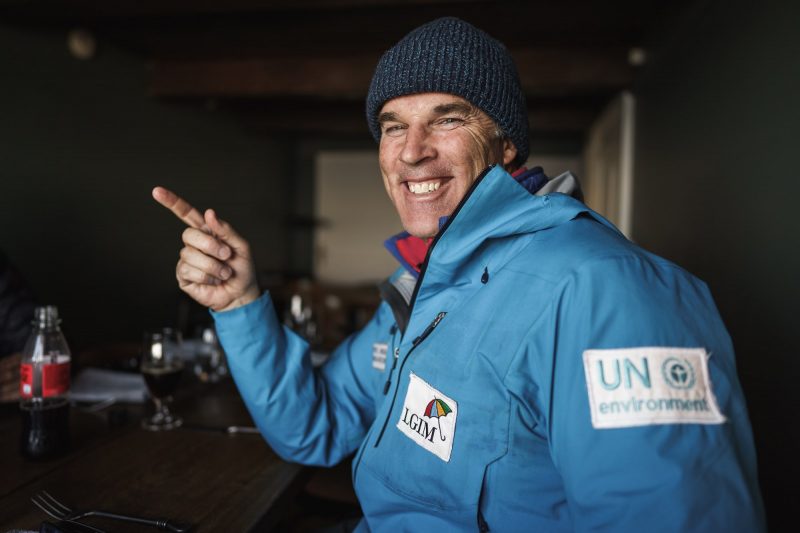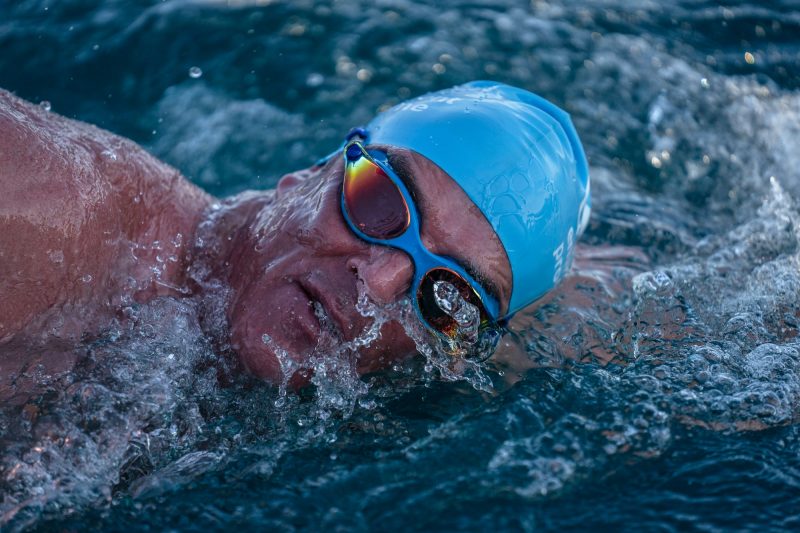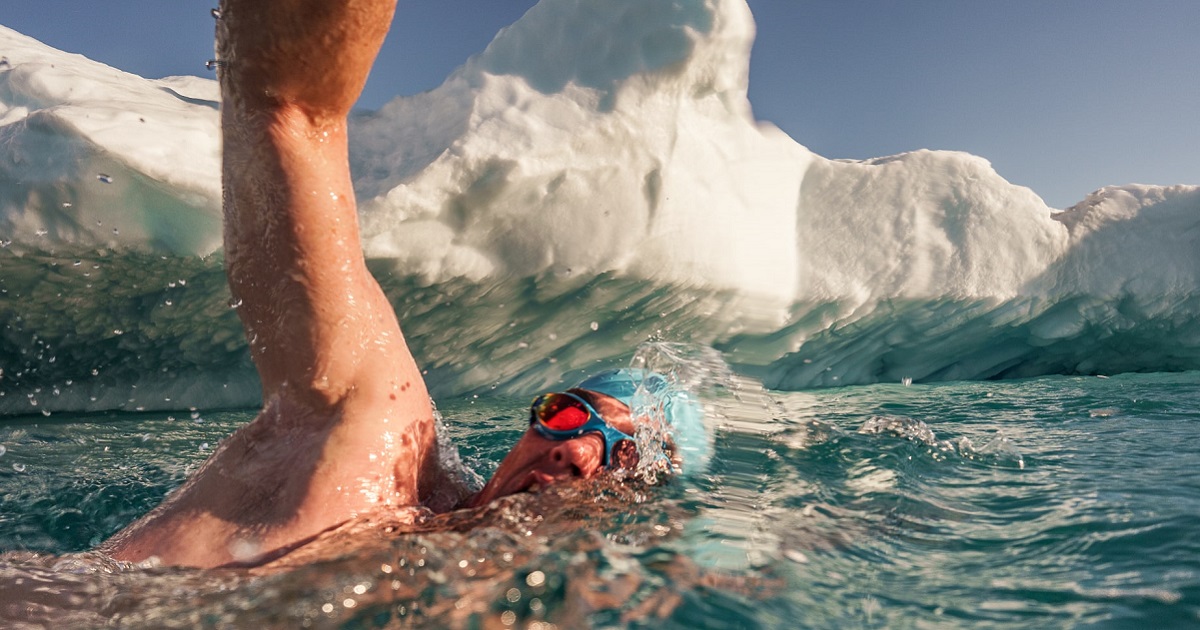Water Borne Change
Famously armed with nothing but a swimming cap, a pair of Speedos and goggles, Lewis Pugh is an endurance swimmer who braces icy waters to highlight the climate crisis. Reyana Nacerodien reports. This article was first published in In Focus issue 9 magazine.
Through his swims, and out of the water, British-South African endurance swimmer and ocean advocate Lewis Pugh, advocates for our oceans and planet at large, illustratively affirming, ‘No message, no swim.’ The 51-year old’s expeditions have further brought about some valuable life lessons.
Early Swims
At just 17 years old, Lewis swam from Robben Island off the southern coast of South Africa, the small island where Nelson Mandela was famously imprisoned, to Cape Town. ‘The Robben Island swim taught me that finishing a job gives you the power and the energy to go on to even bigger things,’ he says. Now, more than four decades later, he has cemented his place in history with a number of swims.
The Arctic North Pole is basically uninhabitable. Receiving no direct sunlight, the geography is notorious for moving ice. But in 2007, Lewis completed a long distance swim across the Geographic North Pole. The one-kilometre swim took 18 minutes and 50 seconds which he spent in minus 1.7 degrees Celsius water. ‘I had never been more frightened than I was standing on the edge of the sea ice. Minus 1.7 degrees Celsius was the coldest water any human had ever swum in. The previous day’s test swim had gone horribly wrong. The water was ink black, and it was 4.2 long, cold kilometres to the bottom. And there might be polar bears,’ he recalls.
‘But the reason I was right to be terrified, was that I shouldn’t have been able to swim at the North Pole in the first place. Two years previously, 23 per cent of the Arctic ice cover had melted. I was swimming to draw the world’s attention to the effect of climate change on the Arctic,’ Lewis says. To date, he has completed more than 40 successful swims and frequently in vulnerable or compromised ecosystems to draw attention to those. Getting into the water and having to face a range of conditions, challenges and potential threats puts both body and mind to the test. To this he says, ‘When you have purpose, everything becomes possible.’

2021: The Ilulissat Icefjord
When this article was written, Lewis was embarking on yet another swim to highlight environmental impacts and climatic conditions. This most recent expedition saw him swimming across the mouth of Greenland’s Ilulissat Icefjord, which is fed by the world’s fastest-moving glacier. The Arctic is one of the most rapidly warming regions of the planet, with temperatures increasing at 2-3 times the global average – a phenomenon known as ‘Arctic Amplification’.
The Arctic is feeling the effects of the climate crisis more dramatically than anywhere else on Earth, with glaciers, sea ice and permafrost all melting. The glacier lies south of Ilulissat on the west coast of Greenland, 250km north of the Arctic Circle. In what is the first multi-day polar swim ever attempted, Lewis plans to highlight the scale and pace of the climate crisis. These are evident in the accelerated scale and pace at which the glacier is melting – a reality caused by warming air and ocean temperatures. ‘Currently, the glacier discharges around 30 cubic kilometres of ice per year into the sea. If the entire Greenland Ice Sheet were to melt, it would lead to a global sea level rise of over seven metres. Any sea-level rise will be devastating, with one billion people living less than 10 metres above sea level, and around 230 million within one metre. This includes those living in London, Tokyo and New York,’ Lewis says.
Science shows that changes in the Arctic are also impacting climate and weather patterns further south in North America and Europe. The Intergovernmental Panel on Climate Change (IPCC) forecasts a global mean temperature rise of between 1.5 degrees Celsius and 5.5 degrees Celsius over the next century but that’s likely to be even higher in the Arctic. ‘There’s no better place in the world than Ilulissat to show the dramatic impact of the Climate Crisis. This is ground zero,’ adds Lewis.
The Ilulisat or Jakobshavn Glacier is legendary. A UNESCO World Heritage Site, it’s the world’s fastest moving glacier. It moves at an average of 30 m per day. Due to its sheer size and speed, it’s one of the most studied glaciers in the world. Legend has it calved the iceberg that sank the Titanic. For the past few centuries, the Ilulisat has highlighted the devastating impact of atmospheric and ocean warming in the Arctic and developed our understanding of how glaciers are responding to climate change.
In planning the expedition, it was foreseen that the distance Lewis would swim may be considerably more than the 10-kilometre mouth of the Icefjord given harsh conditions marred by icebergs and brash ice. The water’s near freezing, and the wind chill could plummet temperatures deep into negative numbers. The swim was expected to take two weeks. No one has ever attempted a multi-day swim in the Polar Regions.
Taking Action
By plunging into freezing water and, quite literally, putting his life on the line, Lewis draws attention to the climatic plight and pushes world leaders to act. Later this year, Lewis will attend UN Climate Conference (COP26) in Glasgow. He’ll use the story of his swim to impress upon world leaders the speed of the Climate Crisis. He’ll ask them to move beyond long-term commitments toward urgent action. As UN Patron of the Oceans, Lewis will also stress the role healthy oceans play in mitigating against climate change, by calling for 30 per cent of the world’s oceans to be protected.
‘No one will escape Climate Change. It will affect every creature on this planet, great or small. The devastation of our natural world will affect every single person on this planet, every future generation, and the whole of the animal kingdom. It will impact every nation and every business,’ says Lewis. ‘We can avert the worst effects of climate change if we meet the Paris Agreement to limit warming to well below two degrees Celsius above pre-industrial temperatures.
Final Strokes
Tackling the climate crisis is the defining issue of our generation. But to do that we have to act fast and we have to start now. We are in a race against time. Protecting oceans alone won’t solve the climate crisis, but global warming cannot be stopped without ocean protection. What’s more, life on earth depends on healthy oceans. ‘If you’ve got a problem and you multiply it by 50 million people, it becomes unsolvable, but if you’ve got a problem and you divide it by 50 million people, it becomes solvable. We have a brief window of opportunity to solve this crisis. The opportunity will soon be behind us,’ Lewis warns.
SIDEBAR:
Swim to Action
In 2018, Lewis Pugh swam the length of the English Channel to call for 30 per cent of the oceans to be protected by 2030. At the end of the swim, then British environment minister Michael Gove was on Dover Beach to congratulate Lewis and told him that he would support their 30×30 campaign. One month later, the United Kingdom became the first major economy to pledge to this commitment at the UN. To date, 86 nations have joined what amounts to the biggest conservation drive in history. Now their aim is clear: to persuade the remaining 109 nations to join them.

Lewis Pugh’s Swims to Date
Lewis was the first person to complete a long-distance swim in every ocean of the world. Some of his major swims include:
- Swim #1: 17 Sept 1990, around Cape Point in South Africa, 6km, 12 to 17 degrees Celsius.
- Swim #8: 20 Aug 2003, around North Cape in Norway, 5km, 8 degrees Celsius.
- Swim #14: 15 Aug 2004, length of Nærøyfjord in Norway, 18km, 6 to 18 degrees Celsius.
- Swim #19: 14 Dec 2005, off Peterman Island in Antarctica, 1km, 0 degrees Celsius.
- Swim #26: 23 May 2010, across Lake Pumori at Mt Everest in Nepal, 1km, 2 degrees Celsius.
- Swim #34: 19 Mar 2015, off Cape Adare at Ross Sea in Antarctica, 540 metres, -1.7 degrees Celsius.
- Swim #38: 15 Jul 2017, along edge of Arctic sea ice at Spitsbergen Arctic, 1km, -0.1 to -0.6 degrees Celsius.
- Swim #41: 23 Jan 2020, sub glacial river at East Antarctica, distance unknown as under the ice, 0.1 degrees Celsius.
Beyond swimming, some of Lewis’ achievements include:
- 2019 – awarded the Mungo Park Medal by the Royal Scottish Geographical Society for an outstanding contribution to geographical knowledge in a potentially hazardous environment.
- 2014 – named one of National Geographic’s Adventurers of the Year in 2015.
- 2013 – inducted into the International Marathon Swimming Hall of Fame, the highest honour in swimming.
- 2013 – appointed as the UN Patron of the Oceans to be a voice for the world’s oceans, for the penguins, whales, sharks, seals and all its magnificent creatures.
- 2010 – appointed a Young Global Leader by the World Economic Forum.
- 2009 – awarded the Order of Ikhamanga (Gold Class), South Africa’s highest honour.
Photos from Lewis Pugh Foundation.
